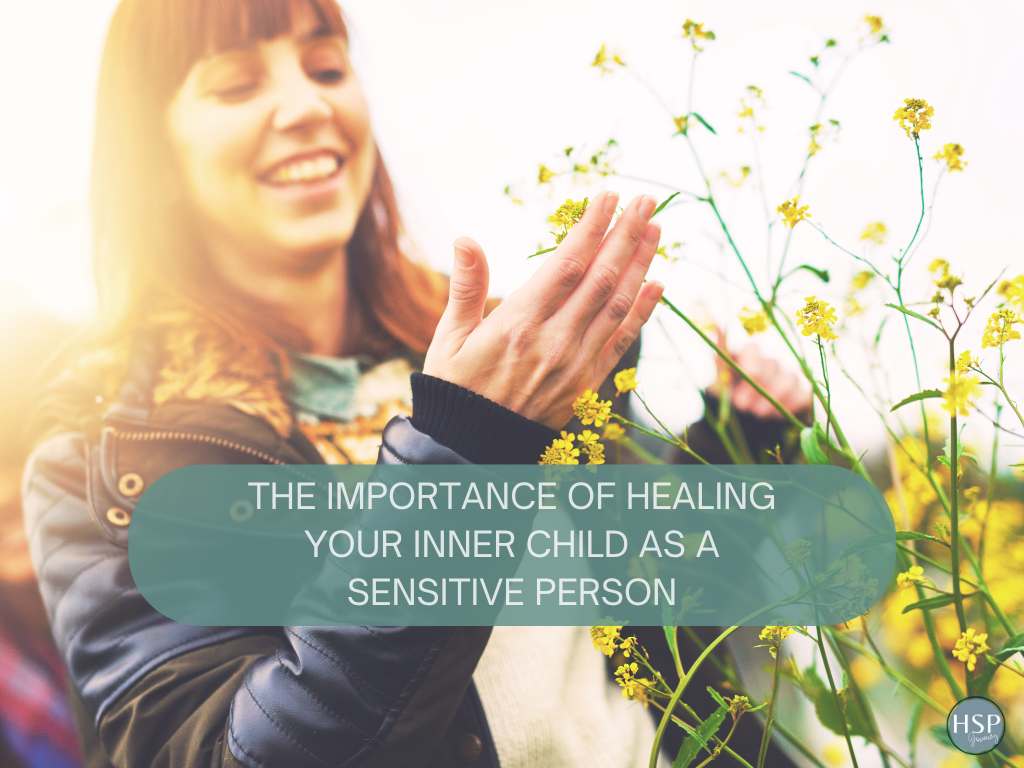Inner child struggles can profoundly impact your adult life as a sensitive person, shaping behaviors and relationships in ways you may not realize. These challenges often stem from unmet needs or unresolved experiences from childhood. Who would have thought that what you did or did not get from your parents would cause you so much grief later in life. As a person who desires to get to the root of things that still affect you today, healing your inner child as a sensitive person is key to moving onward.
Recognizing and addressing your inner child’s struggles can lead to personal growth, improved relationships, and enhanced emotional well-being. This process involves acknowledging past hurts, validating your childhood experiences, and learning to nurture yourself in ways you may have missed.
You might notice signs of inner child struggles in your everyday life. These can include difficulty trusting others, fear of abandonment, or patterns of self-sabotage. By exploring these issues, you can begin to heal old wounds and create a more fulfilling present. Frequently, I find my coaching clients bump up against their inner child issues as they get close to attaining new goals. Noticing these patterns can be pivotal to reaching your heightened awareness that can bring about growth and peace.

Table of Contents
Understanding the Inner Child
The inner child represents our early experiences and emotions that shape our adult selves. It plays a crucial role in our psychological well-being and relationships.
Defining the Inner Child Concept
The inner child is a psychological concept originating from Carl Jung’s work. It refers to the childlike aspect within your adult self that holds your memories, experiences, and emotions from childhood. This part of you can influence your behavior, reactions, and decision-making as an adult.
Your inner child embodies both positive and negative experiences. It can be a source of creativity, playfulness, and wonder. Conversely, it may also harbor unresolved pain or trauma from your past.
When we befriend our inner girl or boy, we can bridge the gap between what we need, what we deny ourselves, and what we need as adults.
Identifying Signs of a Wounded Inner Child
A wounded inner child often manifests through various emotional and behavioral patterns for highly sensitive people. You might struggle with low self-esteem, fear of abandonment, or difficulty trusting others. Perfectionism, people-pleasing tendencies, and challenges in setting boundaries are common signs.
You may find yourself easily triggered by situations that remind you of childhood experiences. Overreacting to criticism, feeling unworthy of love, or engaging in self-sabotaging behaviors can indicate inner child wounds.
Pay attention to recurring relationship patterns or persistent negative self-talk. These often stem from unresolved childhood issues.
The Impact of Childhood Experiences on Adult Life
Your childhood experiences significantly shape your adult personality and relationships. Positive experiences foster resilience, self-confidence, and healthy coping mechanisms. Negative experiences can lead to emotional difficulties and maladaptive behaviors.
Many HSPs find that they have more acute childhood traumas that they had to navigate. Childhood trauma, such as abuse, neglect, or loss, can have long-lasting effects. You might struggle with anxiety, depression, or difficulty forming secure attachments. These challenges can impact your career, relationships, and overall well-being.
Finding a coach or therapist who is adept at helping their clients through inner child issues can be the key to unlocking the door.
Recognizing the influence of your childhood allows you to address underlying issues. By understanding your inner child, you can work towards healing past wounds and developing healthier patterns in your adult life.

Looking for an HSP-Trained coach to help you align your life with your priorities?
Through my Highly Sensitive Person (HSP) certification with the Nickerson Institute, as well as being an HSP, I offer HSP coaching to develop specific goals around your HSP needs. We HSPs frequently deal with anxiety and overstimulated nervous systems that prevent us from achieving peace and attaining our life goals. HSP coaching with me includes a detailed review of your sensitivities and a mutually-desired plan for growth and management of this superpower to shift negativity and begin seeing yourself as the hero of your own story.
The Healing Process
Inner child healing involves reconnecting with and nurturing your younger self. This process requires patience, self-compassion, and creating a safe environment for growth and healing.
Stages of Inner Child Healing for the Highly Sensitive Person
Inner child work typically progresses through several stages. You begin by acknowledging your inner child’s existence and recognizing their unmet needs. Next, you establish communication with your younger self through visualization or journaling.
As you build trust, you start to validate your inner child’s emotions and experiences. This validation helps you understand how past events shaped your current behaviors and thought patterns.
The final stage involves reparenting yourself. You learn to provide the love, support, and guidance your inner child needed but didn’t receive. This process helps you develop healthier coping mechanisms and relationship patterns.
Developing Self-compassion and Self-acceptance
Self-compassion is crucial in healing your inner child. Treat yourself with kindness and understanding, especially when facing difficult emotions or memories. Recognize that your past experiences and coping mechanisms were survival strategies.
Practice positive self-talk and challenge negative beliefs about yourself. Affirmations can be powerful tools in rewiring your thought patterns. For example:
- “I am worthy of love and respect.”
- “My feelings are valid.”
- “I accept myself as I am.”
Embrace your imperfections and celebrate your strengths. Self-acceptance allows you to move forward without being held back by past wounds.
Creating a Safe Space for Healing
Establish a physical and emotional environment that feels secure for your inner child work. This safe space can be a quiet corner in your home or a peaceful outdoor location.
Incorporate comforting elements like soft blankets, soothing music, or childhood mementos. These items can help you feel protected and nurtured during healing sessions.
Set boundaries with others to protect your emotional well-being. Learn to say no to situations or people that don’t support your healing journey. Surround yourself with supportive individuals who respect your growth process.
Consider seeking guidance from a therapist experienced in inner child work. They can provide additional tools and support as you navigate this healing journey.
Practices for Nurturing the Inner Child
Nurturing your inner child involves intentional practices that foster emotional healing and personal growth. These techniques can help you reconnect with your authentic self and address unresolved childhood issues.
Mindfulness and Emotional Regulation
Mindfulness practices can help you tune into your inner child’s emotions and needs. Try deep breathing exercises to calm your nervous system when feeling overwhelmed. Set aside 5-10 minutes daily for inner child meditation, visualizing yourself comforting your younger self.
Practice naming and accepting your emotions without judgment. This helps develop emotional intelligence and self-compassion. When strong feelings arise, pause and ask yourself, “What does my inner child need right now?
Use grounding techniques like the 5-4-3-2-1 method to bring yourself back to the present moment when caught in past memories or anxieties.
Artistic Expression and Creativity
Engaging in creative activities can unlock your inner child’s playful spirit. Try coloring books, finger painting, or sculpting with clay to tap into childlike wonder and self-expression.
Create a vision board representing your inner child’s dreams and desires. Include images, quotes, and symbols that resonate with your younger self.
Explore music therapy by listening to songs from your childhood or learning a new instrument. Dance freely to release tension and connect with your body.
Write a letter to your inner child, expressing love, understanding, and encouragement. Read it aloud to yourself in a safe, comfortable space.
Journaling and Self-reflection Exercises
Keep a dedicated inner child journal to explore your thoughts and feelings. Write about childhood memories, both positive and challenging, to gain insight into patterns and beliefs.
Try “inner child dialogues” by writing conversations between your adult self and younger self. This can help bridge the gap between past and present experiences.
Use prompts like “If my inner child could speak freely, they would say…” or “A time I felt truly safe and loved as a child was…” to delve deeper into your inner world.
Create a “joy list” of activities that brought you happiness as a child. Incorporate these into your routine to reconnect with simple pleasures and spark joy.
Looking for HSP Tools to Thrive in a Chaotic World?
The modern world is often overwhelming and stressful for those of us with sensitive nervous systems. Many of us have suffered from the challenges of high stress, anxiety, sensory overload, and mental health and physical health issues. Fortunately, after years of working with and researching Highly Sensitive People (HSPs), Julie Bjelland has developed many tools that have not only helped her but thousands of HSPs all over the world move out of survival mode living and into thriving. In this free webinar, she’ll share the tools that HSPs have found the most life-changing. Her goal is to help you live to your fullest potential because the world needs you.
Join this free webinar and get tools to help you thrive as an HSP!
Overcoming Obstacles
Healing your inner child involves confronting challenges and developing new strategies. You’ll need to address self-defeating behaviors, establish boundaries, and seek professional guidance when necessary.
Addressing Self-sabotage and Defense Mechanisms
Self-sabotage can hinder your progress in healing your inner child. You might unconsciously engage in behaviors that undermine your efforts. Recognizing these patterns is crucial:
- Procrastination
- Negative self-talk
- Avoiding difficult emotions
Defense mechanisms, while protective, can also impede growth. Common examples include:
- Denial
- Projection
- Rationalization
To overcome these obstacles, practice self-awareness. Notice when you’re employing these tactics. Challenge negative thoughts and replace them with more balanced perspectives. Journaling can help you track patterns and identify triggers.
Building Healthy Boundaries and Resilience
Establishing boundaries is essential for protecting your emotional well-being. Start by identifying your limits and communicating them clearly to others. Practice saying “no” when necessary.
Resilience helps you bounce back from setbacks. To build resilience:
- Develop a growth mindset
- Set realistic goals
- Celebrate small victories
Coping mechanisms play a crucial role in managing stress. Explore healthy options like:
- Deep breathing exercises
- Mindfulness meditation
- Physical activity
Regularly engage in self-care activities that nurture your inner child. This might include creative pursuits, spending time in nature, or engaging in playful activities.
Seeking Support from Mental Health Professionals
Professional help can be invaluable in your healing journey. A mental health expert can provide guidance tailored to your specific needs. They can help you:
- Uncover deep-seated issues
- Develop effective coping strategies
- Process traumatic experiences
Cognitive-behavioral therapy (CBT) is particularly effective for addressing inner child struggles. It helps you identify and change negative thought patterns and behaviors.
Consider joining support groups or online communities focused on inner child healing. Sharing experiences with others can provide emotional support and practical insights.
Remember, seeking help is a sign of strength, not weakness. You don’t have to navigate this journey alone. I often work with my HSP clients on pinpointing aspects of their inner child that come up in difficult situations.
Frequently Asked Questions
Inner child healing involves recognizing and addressing unresolved childhood experiences. This process can lead to improved emotional well-being and healthier relationships.
What are the signs that indicate your inner child may be wounded?
You might have difficulty trusting others or forming close relationships. Frequent emotional outbursts or mood swings can also signal inner child wounds. Other signs include fear of abandonment, low self-esteem, and repeating unhealthy patterns in relationships.
Perfectionism or a strong need for control may indicate attempts to protect your vulnerable inner child. You might also struggle with setting boundaries or have difficulty expressing your needs and emotions.
What methods are effective for healing a wounded inner child?
Journaling can help you connect with your inner child’s thoughts and feelings. Visualization exercises allow you to imagine comforting your younger self. Therapy, particularly modalities like Inner Child Work or EMDR, can be highly effective.
Practicing self-compassion and positive self-talk helps nurture your inner child. Engaging in activities you enjoyed as a child can reconnect you with your younger self’s joy and creativity.
In what ways can we recognize that our inner child has begun to heal?
You may notice increased self-confidence and a stronger sense of self-worth. Relationships might become more fulfilling as you set healthier boundaries. You’ll likely feel more comfortable expressing your emotions and needs.
A greater sense of inner peace and reduced anxiety are common signs of healing. You might also find yourself more spontaneous and playful in your daily life.
What are the common exercises suggested for healing one’s inner child?
Writing letters to your younger self can be a powerful healing tool. Creating a dialogue between your adult self and inner child through role-play or journaling is also beneficial.
Meditation focused on connecting with your inner child can foster healing. Engaging in art therapy or creative activities can help express and process childhood emotions.
How does a healed inner child impact an individual’s behavior?
A healed inner child often leads to more authentic self-expression. You may find yourself more resilient in the face of challenges. Improved emotional regulation allows for more balanced responses to stress.
Healthier relationships often result from a healed inner child. You might experience increased joy and playfulness in your daily life. Decision-making may become easier as you trust your instincts more.
What defines the concept of ‘inner child wounds’ and how are they classified?
Inner child wounds stem from unmet childhood needs or traumatic experiences. They’re often classified based on their origin, such as abandonment, neglect, abuse, or enmeshment.
These wounds can manifest as emotional, physical, or psychological patterns in adulthood. Classifications might include trust issues, self-worth problems, or difficulty with intimacy.
Be sensitive, be free
*This post contains affiliate links and I will be compensated if you make a purchase after clicking on my links*




